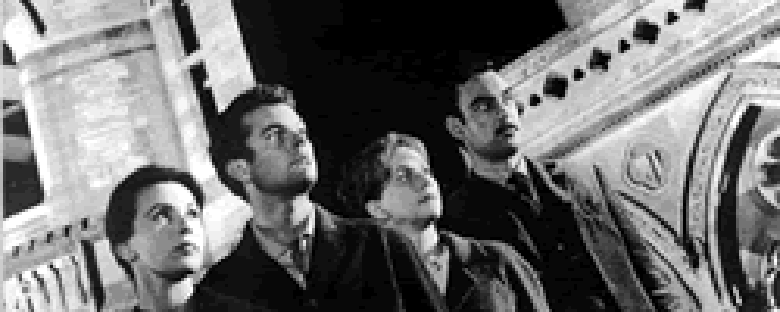Reviews
“A closed mind is the worst offense against the supernatural.”
This line, spoken midway through The Haunting, doubles as clever tagline for the film; it counters the skeptical attitude of a central character, and likewise for similar-mannered viewers. At the time it is uttered there is no tangible proof that ghosts are responsible for troublesome occurrences in a haunted mansion, though evidence is abundant.
Leading a team of four psychological investigators, Professor John Markway contends that we are afraid of the unknown. His assertion is correct. In the film, the unexpected noises (banging on walls, children crying, and footsteps) are less frightening than the fact that no established study reasons their presence.
Markway is an anthropology professor, armed with a PhD, who aims to couple his studies with research of psychic phenomena — to either prove or disprove the existence of supernatural beings. The ill-famed Hill House is where he locates his experiment. The house, upright for over ninety years, is plagued in its tenure by “scandal, murder, insanity” and “suicide.” Markway interprets it as a perfect base for his experiment.
He assembles three more members (there were to be six; two promptly withdrew upon knowledge of the house): Luke is the mansion’s heir, and is young, cocky, and skeptical; Theo is a remarkably accurate psychic and, curiously, a lesbian; Eleanor, finally, is most unstable of the group. Eleanor was chosen for her experience with a poltergeist (her house was rained upon by rocks, inexplicably, for three days — it is the only recorded case of such phenomena). We find, also, that Eleanor’s past is strikingly parallel to one of the house’s past deaths. Each character, importantly, displays a capacity for fear, despite the strength of their threshold (at the time Luke opens his eyes wide in fear, ours are too if not prior).
The four meet at Hill House and inspect it with an eager curiosity that overwhelms their logical fear (the two women have yet to know of the house’s history). Its interior is a vast maze of oddly interconnected rooms. Ominous stone statues strew the scene, inside and out, as do old mirrors that, in their age, provide questionable reflections. There are no cobwebs or streams of dust following one’s stride (such conventions would lessen the horrific strength of the setting); Hill House looks lived-in.
The subjective camerawork establishes no familiarity with the setting, isolating the viewer as it does the characters in the house’s maze. Emotions are manifested in camera movement, as when Eleanor and Theo suspect something outside their bedroom door: the camera zooms and isolates their point of obsession — a slowly turning doorknob.
For every action in the film there is a justifiable excuse, yet as implausible as it is that spirits produce the recurring wails and noises it is less so that the frights are completely imagined. Even upon the film’s conclusion, no formulaic reason or find is given for the haunted house — only suggestions. The Haunting is over forty years old, and it persists to be as effective and scary as any rendition of the same concept.
One of The Haunting’s more disturbingly atmospheric qualities is the personification of Hill House. Eleanor (in frequent voice-over monologues) continually comments on the house’s features, equating its traits with a human’s — on her arrival, she glimpses the house’s vast skyline and thinks, “It’s staring at me.” (The epilogue analogizes the house with a growing body; “Within, walls continue upright, bricks meet, floors affirm, and doors will sensibly shut.”) Throughout the film doors shut without coax every time one is left open. Though it is a possibility that a faulty design of each doorway would be responsible for this, it is grossly impossible that this mansion — a product of rich investment, collaboration, and attention — would suffer such an erroneous architectural mistake.
As with most horror films The Haunting supplies a comedic balance to its horror. This technique functions, when employed successfully (as it is here), to distance the emotional intuition of the viewer: scenes of horror often follow comedy, forcing the viewer to “arrive” at his fear, traveling a length on his emotive scope. (When employed unsuccessfully, incidentally, scenes of horror become funny, and the film is camp.)
The Haunting is a wisely sophisticated horror film of implication, subtlety, and restraint. Watching it now, after roughly three decades of consistently visceral horror films, is speculatively as frightening an experience as it was forty years ago.
We don’t do comments anymore, but you may contact us here or find us on Twitter or Facebook.



